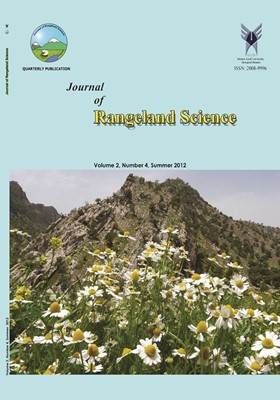Potential of Near-Infrared Reflectance Spectroscopy (NIRS) to Predict Nutrient Composition of Bromus tomentellus
محورهای موضوعی : Relationship between Animal and RangelandHossein Arzani 1 , Anvar Sour 2 , Javad Motamedi 3
1 - Faculty of Natural Resources, University of Tehran
2 - Range Management, From Natural Resources Faculty University of Tehran
3 - Department of Natural Resources, University of Urmia
کلید واژه: Range management, Animal nutrition, N, ADF, DMD, ME, Bromus tomentellus, Near-Iinfrared Reflectance Spectroscopy (NIRS),
چکیده مقاله :
Determination of forage quality of available species is one of the fundamentalfactors for the management of rangelands. Near-Infrared Reflectance Spectroscopy (NIRS)was used to analysis the Nitrogen (N), Acid Detergent Fiber (ADF), Dry MatterDigestibility (DMD) and Metabolizable Energy (ME) content of three phenological stages(vegetative, flowering and seeding) of Bromus tomentellus samples in grazing pastures ofIran. The sample set consisted of 40 samples for calibration and 23 samples for validationwas used to prediction N, ADF, DMD and ME, separately. The samples were measured byreflectance NIR in a 950-1650 nm range. Calibration models between chemical data andNIR spectra were produced using the method of Partial Least Squares (PLS). Thecoefficients of determination (R2) and standard error of cross validation (SECV) were 0.94(SECV: 0.208%), 0.98 (SECV: 1.76%), 0.98 (SECV: 1.97%), and 0.97 (SECV: 0.34%) forN, ADF, DMD and ME, respectively. The results obtained from this study indicated thatNIRS had a potentiality to be used in predict the N, ADF, and the estimated DMD and MEof forage samples content.


